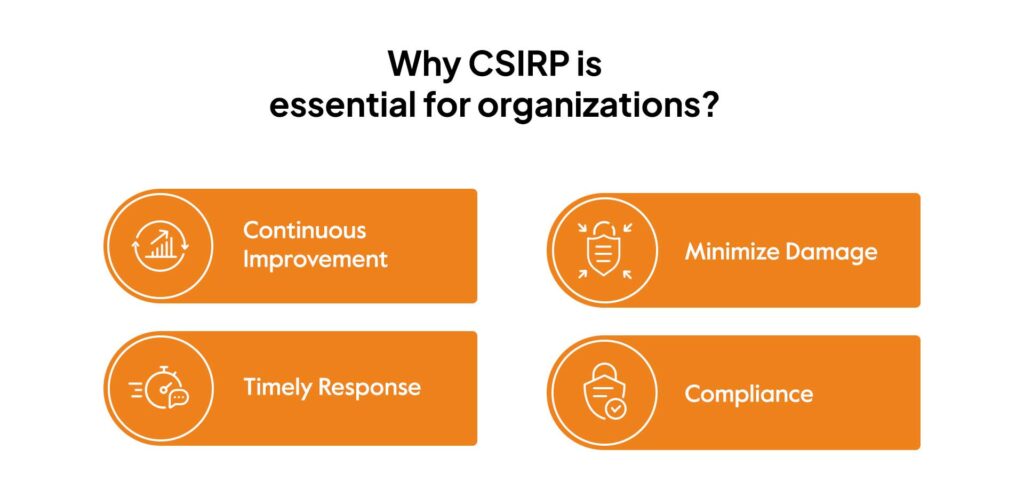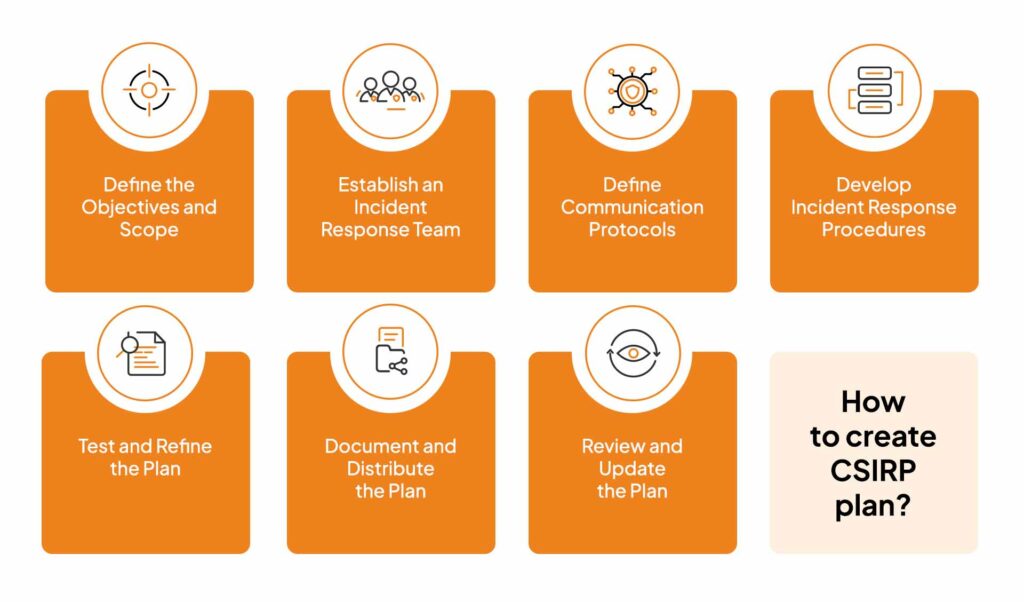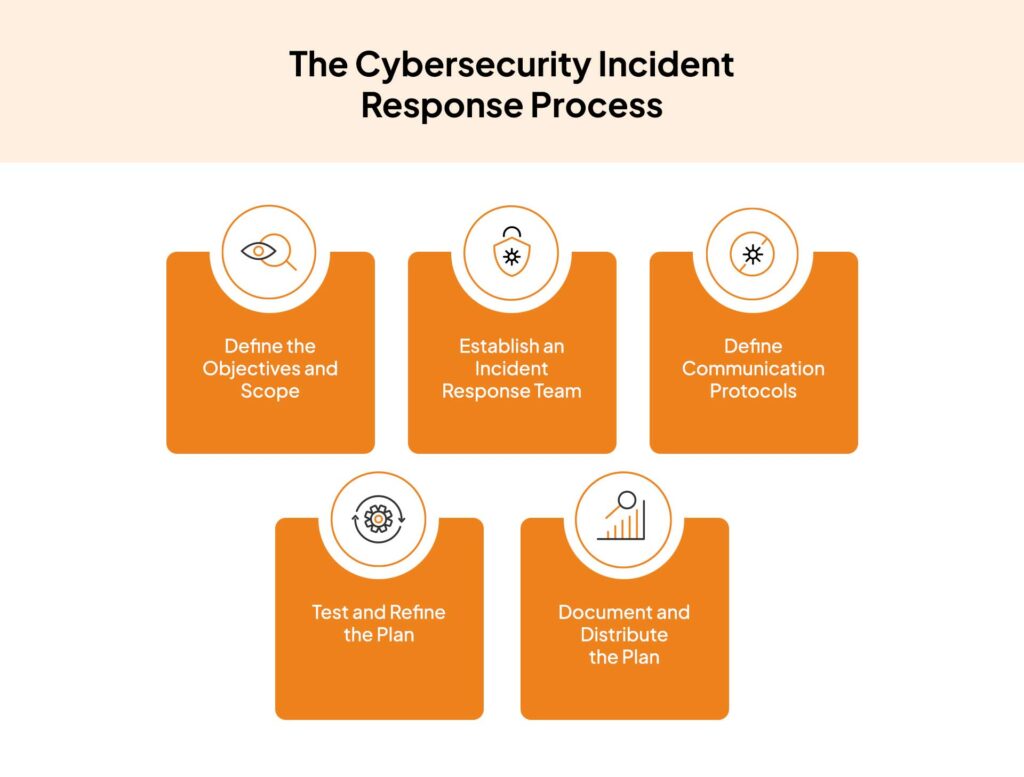Best Practices for Developing a Cybersecurity Incident Response Plan
Shivam Jha
Mar 30, 2024

The significance of cybersecurity is growing. The world now depends on technology more than ever before, and there are no signs that indicate a possible reversal.
Organizations can no longer exclusively rely on standard cybersecurity solutions like firewalls and antivirus software. Hackers are consistently improving their strategies and are now able to easily penetrate traditional cyber defenses. To ensure continuous security, it’s crucial to cover all aspects of cybersecurity.
What is a Cybersecurity Incident Response Plan?
Cybersecurity Incident Response Plan refers to a company’s techniques and processes for spotting and addressing cyberattacks, cyber threats, or security breaches. The goal of incident response is to prevent cyberattacks from happening and to reduce the cost and disruption caused to an organization in the event of an attack.
Ideally, an organization establishes incident response methods and technology in a formal incident response plan (IRP) that outlines how various types of cyberattacks should be discovered, confined, and handled.
An efficient incident response strategy can assist cybersecurity teams in identifying and containing cyber threats, speeding up the restoration of compromised systems, and lowering other associated expenses such as lost profits and regulatory penalties.
Why do organizations need to have Cybersecurity Incident Response Plan?
Here are some reasons why CSIRP is essential for organizations:

Timely Response
A CSIRP helps organizations respond quickly and efficiently to cyber incidents. The plan outlines the roles and responsibilities of different stakeholders, such as IT staff, incident response team, and management, to ensure a coordinated and effective response.
By having a clear and structured plan, organizations can minimize the impact of a cyber attack and reduce downtime.
Minimize Damage
A cyber attack can cause significant damage to an organization, such as loss of data, reputation, and financial losses. A CSIRP provides a framework to manage the incident and minimize the damage. It includes procedures to contain the attack, identify the source, and remediate the issue. By having a CSIRP in place, organizations can quickly recover from an incident and resume normal operations.
Compliance
Many regulatory bodies and industry standards require organizations to have a CSIRP in place. For example, the General Data Protection Regulation (GDPR) mandates organizations to report data breaches within 72 hours. Failure to comply with these regulations can result in severe penalties and fines. A CSIRP helps organizations meet these compliance requirements and demonstrate their commitment to cybersecurity.
Continuous Improvement
A CSIRP is not a one-time exercise. It requires regular testing, updating, and refining to ensure its effectiveness. By regularly reviewing and improving the plan, organizations can identify weaknesses and gaps and implement measures to strengthen their cybersecurity posture.
Let us now have a look at what goes on in creating a Cybersecurity Incident Response Plan.
How to create Cybersecurity Incident Response Plan?
The needs of your company will determine every step of how you’ll create your incident response plan, including how big your company is, how many employees you have, how much sensitive data you keep on hand, etc. But, we’re going to offer some general advice that would be useful for almost any type of organization creating a cyber incident response strategy.

Define the Objectives and Scope
Start by defining the objectives and scope of the CSIRP. Identify the systems, assets, and data that need to be protected and the types of incidents that the plan should cover. This will help you focus on the most critical areas and create a targeted plan.
Establish an Incident Response Team
Create an incident response team comprising stakeholders from different departments, such as IT, legal, communications, and management. Define their roles and responsibilities and provide them with the necessary training and resources to carry out their tasks effectively.
Develop Incident Response Procedures
Develop procedures for responding to different types of incidents, such as malware attacks, phishing scams, and data breaches. Include steps for identifying and containing the incident, notifying the appropriate stakeholders, and restoring systems and data.
Define Communication Protocols
Establish communication protocols for different scenarios, such as notifying internal teams, external stakeholders, and regulatory authorities. Define the channels for communication and the level of information to be shared.
Test and Refine the Plan
Test the CSIRP regularly through simulations and tabletop exercises to identify weaknesses and gaps in the plan. Use the feedback to refine the plan and improve its effectiveness.
Document and Distribute the Plan
Document the CSIRP and distribute it to all relevant stakeholders. Ensure that everyone is aware of their roles and responsibilities and understands the procedures and communication protocols.
Review and Update the Plan
Review the CSIRP regularly and update it as needed to reflect changes in technology, systems, and threats. Make sure the strategy is up-to-date and efficient.
Apart from these, it is essential to know how a Cybersecurity Incident Response Plan works. Let’s have a look at the same in the next section.
The Cybersecurity Incident Response Process
On the basis of incident response models created by the SANS Institute, the National Institute of Standards and Technology (NIST), and the Cybersecurity and Infrastructure Agency (CISA), most IRPs likewise adhere to the same broad incident response framework.

Preparation
This first stage of incident response is ongoing to ensure that the CSIRT always has the best policies and resources available to respond to incidents as rapidly as possible with the least amount of business disruption.
The CSIRT regularly assesses risks to identify network vulnerabilities, categorizes the different security incidents that could endanger the network, and assigns a priority to each category based on the likelihood that it would have an adverse effect on the organization. The CSIRT may revise current incident response plans or create new ones in light of this risk assessment.
Detection and Analysis
Members of the security team keep an eye on the network throughout this stage for any unusual activity or potential threats. They examine information, notifications, and alerts obtained from device logs and from various security technologies (firewalls, antivirus software), which are deployed on the network. They remove false positives and rank the true alerts according to their seriousness.
To assist security teams in monitoring and analysing security events in real-time and automating incident detection and response procedures, the majority of organizations use one or more security solutions today, such as SIEM (security information and event management) and EDR (endpoint detection and response).
The communication plan is also put to the test in this phase. Before going on to the next phase of the incident response procedure, the CSIRT will alert the necessary individuals once they have identified the type of threat or breach they are dealing with.
Containment
The incident response team takes action to prevent the breach from causing the network additional harm. There are two types of containment activities:
- Short-term containment strategies concentrate on isolating the affected systems to stop the current threat from spreading, such as by taking infected devices offline.
- Long-term containment methods put further security protections around unaffected systems to protect them, like separating sensitive databases from the rest of the network.
In order to minimise further data loss and to gather forensic evidence of the incident for further investigation, the CSIRT may also, at this point create backups of both affected and unaffected systems.
Eradication
The team then moves on to complete the cleanup and removal of the threat from the system once it has been contained. In order to do this, the threat must be actively eliminated (e.g., by destroying malware or kicking an unauthorised or rogue user off the network). Affected and unaffected systems must also be examined to make sure no evidence of the breach is still present.
Recovery
The impacted systems are returned to regular operation after the incident response team is certain that the threat has been completely eliminated. This could entail applying updates, reconstructing systems from backups, and reactivating repaired systems and devices online.
Post-incident analysis
The CSIRT gathers evidence of the breach and records the steps it takes to contain and eliminate the threat during each stage of the incident response process. The CSIRT now examines this data to comprehend the situation more fully.
In order to prevent similar occurrences from happening in the future, the CSIRT aims to identify the attack’s primary cause, pinpoint how it successfully infiltrated the network, and fix any vulnerabilities.
In order to reinforce incident response measures against future assaults, the CSIRT also evaluates what went well and looks for chances to improve systems, tools, and processes. Law enforcement may also be involved in the post-incident inquiry, depending on the specifics of the breach.
Sprinto’s take on CSIRP
With the increasing dependence on technology, cybersecurity has become crucial for organisations as cybersecurity incidents are becoming more common. A CSIRP helps organizations respond quickly and efficiently to cyber incidents, minimize the damage caused, comply with regulations, and continuously improve their cybersecurity posture.
Developing a Cybersecurity Incident Response Plan involves defining the objectives and scope, establishing an incident response team, developing procedures, defining communication protocols, testing and refining the plan, documenting and distributing the plan, and reviewing and updating it regularly.
With the right CSIRP in place, organizations can be better prepared to handle cybersecurity incidents and reduce the impact of cyber attacks. That said, you can get in touch with our industry-leading experts who can cut down your compliance time by 70%-90% depending on your framework.
FAQs
What are the 8 basic elements of an incident response plan?
The eight basic elements of an incident response plan are Preparation, Identification, Containment, Eradication, Recovery, Investigation, Notification, and Post-incident activities. With all of these in place, companies can handle cybersecurity incidents well.
What is a good incident response plan?
A good incident response plan is a comprehensive and tested set of procedures that enables an organization to quickly and effectively respond to and recover from security incidents and other disruptions. It should include clear protocols for identifying and reporting incidents, containing and eradicating them, and restoring normal operations, as well as regular training and testing to ensure its effectiveness. Additionally, it should be regularly reviewed and updated based on lessons learned from past incidents.
What is the incident response in SOC?
Incident response refers to the process of quickly identifying, analyzing, and responding to security incidents within an organization’s network or systems. This involves following a predefined set of procedures to contain and eradicate the incident and restore normal operations as quickly as possible.
Shivam Jha
Shivam is our in house cybersecurity sage with over six years of experience in cybersecurity under his belt. He is passionate about making the digital world safer for everyone and whipping up Indian delicacies on the weekend.
Grow fearless, evolve into a top 1% CISO
Strategy, tools, and tactics to help you become a better security leader
Found this interesting?
Share it with your friends
Get a wingman for
your next audit.
Schedule a personalized demo and scale business

Sprinto: Your growth superpower
Use Sprinto to centralize security compliance management – so nothing
gets in the way of your moving up and winning big.


